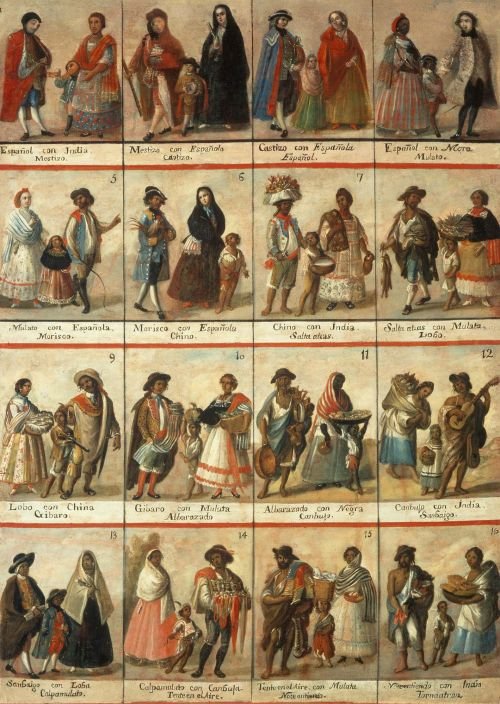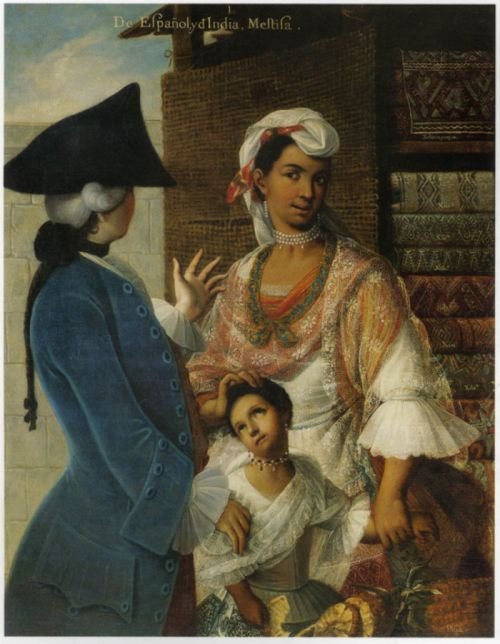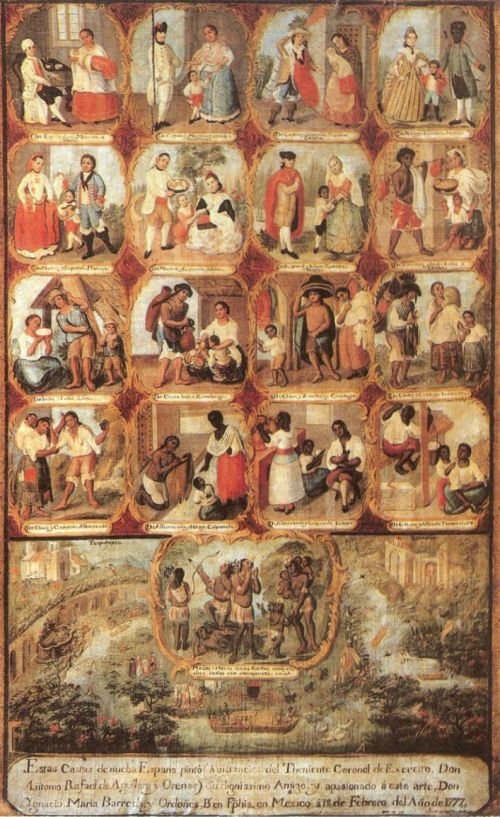What are Castes of New Spain?
Castes of New Spain
What are Castes of New Spain?
The expression castes of New Spain refers to the classification of interracial mixtures in the colonial period (between whites, Indians and blacks), from which the attribution of duties and rights was derived according to the degree of purity of the blood. Therefore, in Hispanic America the concept of castes applied only to the descendants of interracial unions.
What were the castes in New Spain?
In New Spain there were various classifications of the caste system. As a general rule, there used to be a consensus on what to call the main castes (mestizos, castizos, Spaniards, mulattos and Moriscos), since they were clearly represented in official documents.
However, starting with the sixth caste, the various classifications reveal the lack of consensus in language. The differences are reflected not only from region to region but according to the historical moment.
One of the most widespread classifications of the caste system in Mexico derives from an anonymous painting made in the 18th century, in which a total of sixteen castes from New Spain are established . Let's see.
 Caste painting. Anonymous from the 18th century. New Spain.
Caste painting. Anonymous from the 18th century. New Spain.
- Mestizo: Spanish with India
- Castizo: mestizo with Spanish
- Spanish: castizo con español
- Mulato: Spanish with blackberry (black)
- Morisco: mulatto with Spanish
- Chinese: Moorish with Spanish
- Sata back: Chinese with India
- Wolf: jump back with mulatto
- Gíbaro or jíbaro: wolf with china
- Albarazado: gíbaro (jíbaro) with mulatto
- Cambujo: albarazado with black
- Sambaigo ( zambaigo ): cambujo with india
- Calpamulato: sambaigo with she-wolf
- Tente en el aire: calpamulato with cambuja
- I don't understand you: tente in the air with a mulatto
- Torna back: I don't understand you with india
The painter Miguel Cabrera also represented the caste system in his works. The classification that he collects in his 1763 series is the following (note the differences with respect to the previous classification):
 Miguel Cabrera: 1. From Spanish to Indian: mestizo . 1793. Oil on canvas.
Miguel Cabrera: 1. From Spanish to Indian: mestizo . 1793. Oil on canvas.
- Mestizo: Spanish and Indian
- Castizo : Spanish and mestizo
- Spanish: Spanish and Castiza
- Mulato: Spanish and black
- Morisco: Spanish and mulatto
- Albino: Spanish and Moorish
- Back to back: Spanish and albino
- Tente en el aire: Spanish and turn back
- Chino cambujo: black and indian
- Wolf: chinese cambujo and india
- Albarazado: wolf and india
- Barcino: albarazado and mestizo
- Zambuigua: Indian and Barcina
- Chamizo: castizo and mestizo
- Coyote: mestizo and Indian
- Gentile Indians
From the painter Andrés de Islas , this classification from the year 1774 is known:
André de Islas: From Spanish and black, a mulatto is born . 1774. Oil on canvas.
- Mestizo : Spanish and Indian
- Castizo : Spanish and mestizo
- Spanish : Castizo and Spanish
- Mulato : Spanish and black
- Morisco : Spanish and mulatto
- Albino : Spanish and Moorish
- Back to back : Spanish and albino
- Wolf : Indian and black
- Coyote : Indian and mestizo
- Chinese : wolf and black
- Cambujo : Chinese and Indian
- Tente en el aire : cambujo and india
- Albarazado : tente in the air and mulatto
- Barcino : albarazado and india
- Calpamulato : barcino and cambuja
- Barbarian Mech Indians
Another of the classifications of the colonial caste system, eventually in force in both New Spain and South America , is the following:
- Creole : Europeans in America
- Mestizo : Spanish and indigenous
- Castizo , castizo cuatralb or or cuarterón de mestizo : Spanish with mestizo
- Spanish : castizo con español
- Zambo or jarocho : indigenous with black
- Zambo prieto : black with zambo
- Mulato : Spanish with black
- Morisco (different from Peninsular Moors) or cuarterón de mulata : mulatto with Spanish
- Albino or octavón : Spanish with Moorish
- Jump back or jump back : albino with Spanish
- Crowded : mestizo with mulatto
- Cholo , coyote or meslindio : indigenous with mestizo
- Chinese or dark mulatto: mulatto with indigenous
- Galfarro : mulatto with black
- Harnizo : Spanish with cholo
- Harnizo : castizo with mestizo
- Chamizo or chamiso : coyote with indigenous
- Half-breed coyote: chamizo with half-breed
- Cambujo : Chinese with indigenous
- Wolf : jump back with mulatto
- Gíbaro or jíbaro : wolf with Chinese
- Albarazado : gíbaro with mulatto
- Cambujo : albarazado with black
- Sambaigo : cambujo with indigenous
- Campamulato : sambaigo with wolf
- Tente en el aire : campamulato with cambujo
- I don't understand you : tente in the air with a mulatto
- Torna back : I don't understand you with india
Along with this classification, expressions such as thirdons , cuarterones or quinterones (and successive ones) were also used to name those people with an apparent white appearance, but who carried a third, fourth or fifth part of black or indigenous blood.
Origin of the castes in New Spain
Before arriving in America, Spanish society used the concept of caste to distinguish "old Christians" from "new Christians" (Jews and Moorish converts). Upon arriving in America, they associated it with miscegenation, that is, with the mixture of races . Let's see how it happened.
In its broadest sense, the social groups of New Spain and Latin America were made up of Spanish whites who, as the dominant elite, occupied the apex of the social pyramid. Behind them were the white criollos (sons of Spaniards born in America); the natives (original inhabitants of the continent) and the blacks (slaves brought from Africa). From the interrelation between all of them, a particularly complex new broad group would result: the mestizos .
In an interracial society dominated by Spaniards but with little presence of Spanish women, miscegenation was favored and very soon justified under the ideological principle of cleansing and blood whitening .
It was believed that the mixing of whites with indigenous people could eventually result in the formation of a "white" offspring. Blacks were excluded from this belief, and they were held responsible for "staining" the race.
Hence, the hierarchy of castes in New Spain and Latin America was defined by virtue of the degree of Spanish blood, that is, by virtue of the "purity" of the descendants of interracial unions. The higher the purity (Spanish blood), the more rights; to a lesser degree, reduced duties. Thus the colonial caste system was generated
Caste painting
 Ignacio María Barreda: The Mexican castes . 1777. Oil on canvas.
Ignacio María Barreda: The Mexican castes . 1777. Oil on canvas.
In the 18th century, a pictorial genre emerged in Spanish America, especially in New Spain, called caste painting , in which the castes of colonial society were represented.
In these paintings you could see father, mother and son, as well as clothing, food and trades characteristic of each caste. Even temperament or character traits were also attributed to the characters represented, which often accentuated social prejudices based on race and gender.